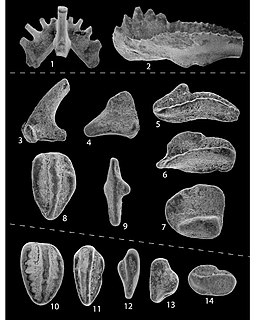Related Research Articles

Conodonts are an extinct group of agnathan (jawless) Fish resembling eels, classified in the class Conodonta. For many years, they were known only from their tooth-like oral elements found in isolation and now called conodont elements. Knowledge about soft tissues remains limited. They existed in the worlds oceans for over 300 million years, from the Cambrian to the beginning of the Jurassic. Conodont elements are widely used as index fossils, fossils used to define and identify geological periods. The animals are also called Conodontophora to avoid ambiguity.
In the geological timescale, the Llandovery Epoch occurred at the beginning of the Silurian Period. The Llandoverian Epoch follows the massive Ordovician-Silurian extinction events, which led to a large decrease in biodiversity and an opening up of ecosystems.

Hindeodus is an extinct genus of conodonts in the family Anchignathodontidae. The generic name Hindeodus is a tribute to George Jennings Hinde, a British geologist and paleontologist from the 1800s and early 1900s. The suffix -odus typically describe's the animal's teeth, essentially making Hindeodus mean Hinde-teeth.
Paleontology or palaeontology is the study of prehistoric life forms on Earth through the examination of plant and animal fossils. This includes the study of body fossils, tracks (ichnites), burrows, cast-off parts, fossilised feces (coprolites), palynomorphs and chemical residues. Because humans have encountered fossils for millennia, paleontology has a long history both before and after becoming formalized as a science. This article records significant discoveries and events related to paleontology that occurred or were published in the year 1933.
Wurmiella is an extinct conodont genus.
Spathognathodontidae is an extinct conodont family ranging from the Silurian to the Devonian.
Acodus is an extinct genus of conodonts.
Idiognathodus is an extinct conodont genus in the family Idiognathodontidae.

Gnathodus is an extinct conodont genus in the family Idiognathodontidae.
Protognathodus is an extinct conodont genus in the family Idiognathodontidae.
Icriodus is an extinct conodont genus in the family Gnathodontidae.
Heinz Walter Kozur was a German paleontologist and stratigrapher.

Acanthodus is an extinct genus of conodonts.
Kallidontus is an extinct genus of conodonts.

Variabiloconus is an extinct genus of conodonts.
Pterospathodus is an extinct genus of conodont from the Silurian period.
Patrognathus is an extinct genus of conodonts.
Idiognathoides is an extinct genus of conodonts.

Cavusgnathus is an extinct genus of conodonts.
Parvigondolella is an extinct genus of Late Triassic conodonts. The most common species in the genus, Parvigondolella andrusovi, is used as an index fossil for part of the Sevatian substage of the Norian stage. Kozur & Mock, 1991 named two additional species, P. rhaetica and P. vrielyncki. Moix et al. (2007) later argued that "Misikella" rhaetica was a species of Parvigondolella. In order to prevent having two different species with the same name within the genus, they renamed Kozur & Mock (1991)'s P. rhaetica to P. prorhaetica. However, this would be unnecessary if "Misikella" rhaetica was not related to Parvigondolella. Parvigondolella is typically considered a direct descendant of Mockina/Epigondolella bidentata.
References
- ↑ New Pennsylvanian conodonts from Oklahoma. RW Harris and RV Hollingsworth, American Journal of Science, March 1933, Series 5, Vol. 25, no. 147, pages 193-204, doi : 10.2475/ajs.s5-25.147.193